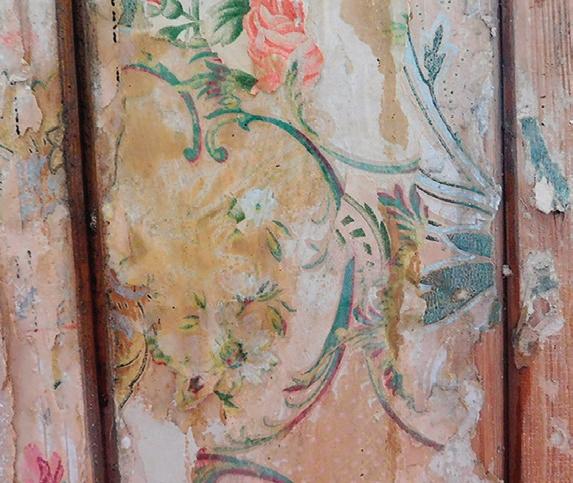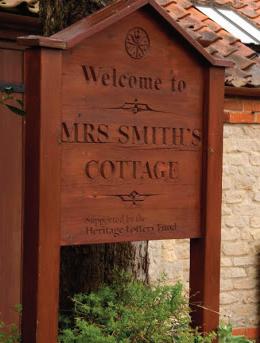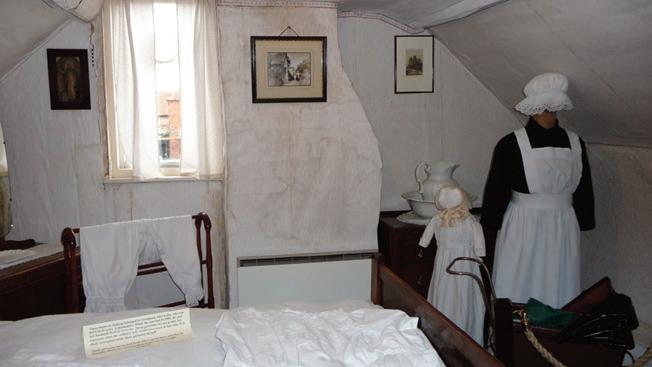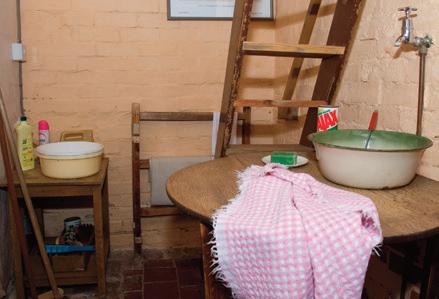
11 minute read
AT HOME WITH MRS SMITH

Advertisement
T HERE’S SOMETHING FAMILIAR about the date. It rings a bell, somehow. 26th June? Let me check my diary.
Ah yes! A garden party. In Navenby. To help celebrate the reopening of Mrs Smiths Cottage, appended with ‘cancelled,’ like my other diary commitments over the summer, including the county show, which would have taken place on the previous days.
It’s a shame when events are cancelled, but the loss of an opportunity to celebrate the reopening of Mrs Smith’s Cottage is especially disappointing for the very hard working team at North Kesteven District Council, who have tried to ensure the place would be ready for visitors once more this summer following a National Lottery Heritage Funded (NLHF) renovation which has taken seven years to complete. We use the term renovation, but actually that’s an expression which should be used carefully. You see, Mrs Smith’s Cottage is unique in the respect that since its owner left the property in 1995, it has been a sort of time capsule, a glimpse into village life that’s simultaneously ordinary and yet somehow quite extraordinary. So who was Hilda Smith? She was a villager living in Navenby. She was a much-beloved part of the community, a familiar figure to most in the village, and yet, she was also... well, she was quite ordinary. “This isn’t the story of a grand person,” says Sally Bird, perhaps the person who could be considered most likely to be frustrated by the cancellation of the cottage’s reopening. “Organisations like the National Trust or English Heritage perform a really important role in taking some of our oldest and most demanding buildings and maintaining them for future generations.” “But typically they’re the former homes and estates of wealthy people. Mrs Smith’s Cottage, by contrast, is the home of someone you would have known and seen and spoken to in the village each day. Indeed, most of the residents did know her and speak to her, which is why they got together to preserve her cottage when Hilda died in May 1995 and left the cottage to family friends, who thought it was important to preserve it... preserve her.” “This is history at its most relatable, because her cottage is the kind of property that most recent generations of Lincolnshire people would have lived in.” Hilda was resistant to some - though not all - change throughout her life. She adopted new technology and acquired new possessions only if she saw a genuine advantage, and embraced a sense of ‘make do and mend,’ living the sort of frugal life that would these days be feted as sustainable but was then merely the convention followed by a generation who had lived through rationing and a life prior to frivolous consumerism. Because Hilda’s cottage changed so little, it has become an illustration of history, albeit one whose owner was sometimes a paradox. For instance, Mrs Smith was resistant to the council fitting running water and drainage in 1978 - the local council wrote to her to insist she have proper facilities installed, because they were to cease offering the service of emptying privies. She failed to see the point in plumbing and still drew her running water from the village pump. And yet, Hilda was one of the first to have electricity installed in the 1930s, long before some other households. Hilda lived her life without a washing machine or twin-tub and without a cooker - preferring her modest cast iron range - and without a refrigerator, too. She did, however, have a radio which she enjoyed listening too immensely, and from around the mid-1970s, a TV too... although it was a modest set, rather than the flat-screened, remote-controlled, multichannel, wi-fi equipped ‘smart TVs’ we watch today which have undoubtedly improved the viewing experience, though, alas, not the programmes themselves. >>
Mrs Smith’s ‘Best Room’: The cottage, built in the 1830s, gained its second half a decade or so later. It was used as a shop or workshop, hence the large window. A washhouse was added later too. The house gained electricity in the 1930s and running water in the late 1970s.




Top/Above: Hilda Craven was born in 1892, orphaned at an early age and brought up by Mary Barrand. She left school in 1906 and worked as a ‘day girl’ for local butcher Mr Dawson. She returned to the village after living in North Yorkshire in 1926, working as a bookkeeper and marrying Joseph Smith in 1956.

>> Another convenience Hilda afforded herself was an electric boiler for washdays. Her 1930s kitchen range from Duckerings of Lincoln may look quaint, but its meagre capacity meant a scant supply of hot water - just two gallons in the tank - for when she would scrub her clothes in her dolly tub.
The range was rather more useful for cooking, though, and Hilda created her own jams and pickles. She also had a well-tended allotment, and would store meat and cheese, butter and milk in the meat safe.
“The front garden is undoubtedly beautiful, but it wasn’t used for growing food, since she had her allotment,” says Sally. “So really it was used for growing flowers and we’re now in the process of restoring the planting scheme according to the inventory of her garden she maintained... we’re currently planting the garden to match a 1986 inventory Mrs Smith had written of her plants in the back of her diary.”
“Mrs Smith kept an amazingly detailed record of her life, writing her diary from her bureau in the ‘best’ room. The room also

contained her sofa, two armchairs and the kind of tiled fireplace that ensures everyone remarks ‘oh, so-and-so had a fireplace just like that!’”
Hilda’s writings and her diary, written at that bureau, are the other aspect of the cottage which ensures her life can be so well observed. Because she documented her experiences, her life - even though she would have perhaps considered it unremarkable at the time - social historians have a rich primary source of ‘normal’ life. “The property closed in 2013 because of serious structural issues. The cottage’s walls are just a single-brick in thickness with no cavities. The shifting of beams left it in danger of structural failure.” “Most similar buildings would have either fallen down or been improved or replaced. Thankfully this one was preserved but its renovation presented real problems because ordinarily the building would just be replaced with something more substantial.” “That’s why work has taken so long; it was a tricky process deciding what to do to fix it technically whilst preserving the building’s integrity. In 2016, as we submitted our National Lottery Heritage Fund (NLHF) bid, we started to assess the work needed to secure the future of the cottage. With the support of Lincoln Conservation and Grevatte & Co we were able to carry out new research into the fabric of the building and work with the local community to identify the stories we wanted to tell.” “In 2018 our NLHF funding had been secured and permission granted to carry out repairs and works to the new visitor centre, located in the adjacent property which NKDC purchased in 2017. Since work began a strong team has developed who have breathed life back into the cottage, running events and working with the local community to tell Mrs Smith’s story.” “This will be serve as a visitor centre with temporary exhibitions both about Mrs Smith and her cottage but rural life more generally. The cottage will, happily, also have a visitor toilet for the first time too, >>
>> but the extra space will also afford us a chance to do more with the site - like creating a mini-allotment similar to that which Mrs Smith would have had - without compromising the integrity or layout of the cottage.”
“That’s really the fine line we’ve had to tread. We want to ensure the site is safe, of course, and has as much for visitors to see and learn from as possible.”
“But I think we’re also responsible for preserving the authenticity and integrity of the building too. Preserving it to ensuring it’s fit for its purpose of education and heritage.”
The building was never intended to accommodate 20,000 people, which is how many had visited the cottage by 2012. And whilst Hilda still used the rickety ladder to the first floor at the grand old age of 102, it’s less practical for visitors to do the same. In a consumption-led era, we replace perfectly serviceable smartphones when a ‘new’ model reaches retailers, and we replace cars on finance packages with new models every three years or so. Manufacturers of such products are keen to tell us how sustainably the products are made and how readily they can be recycled. But the mere fact that we replace our trappings so voraciously despite the fact they still function well enough makes a mockery of any such claims of sustainability. Mrs Smith, on the other hand, was Hilda Smith content with her home and its contents, con1892-1995


Hilda Smith nee Craven was brought up by adoptive mother Mary Barrand and lived in her cottage after marrying Joseph Smith in 1956. She died in 1995 aged 102.

Above: The first floor of the cottage is accessed by two ladders. There are two bedrooms, and Hilda’s halfbrother Fred lived in the cottage for a time as well.
Find Out More: Mrs Smith’s Cottage is now reopen to visitors on East Road, Navenby. For more information call 01522 811469 or see mrssmithscottage.com.

servative with her consumption and embraced the notion of a ‘sustainable’ lifestyle before such a term was coined.
Far too much history is imprisoned behind a glass case or reflects only a gentrified population. But here, in rural Lincolnshire, is a site that’s more relatable than perhaps any other museum or stately home in the county. One which offers the chance to see, but also smell and touch history as we would have known it.
The only comparison we could make is that Mrs Smith’s Cottage is a more modest version of County Durham’s Beamish. Its authenticity, relevance and the excellent manner in which The NKDC team, National Lottery Heritage Fund and partners have worked to preserve it makes a visit now that the site is reopen an absolute must... it’s still a shame about the garden party, though! n
Our Mini MUSEUMS
SOME MUSEUMS IN THE COUNTY ARE SMALL... BUT PERFECTLY FORMED!
n Sleaford Museum: Sleaford Museum is adjacent to the town’s Handley monument and is one of the dinkiest but most wonderful museums in the county. Temporary exhibitions are beautifully curated and the team of volunteers who work in the place are incredibly friendly. Previous exhibits have centred around local businesses like Charles Sharpe’s seed business or Lee & Green’s mineral water company, as well as the 100th anniversary of the RAF. www.sleafordmuseum.org.uk
n Woodhall Spa Cottage Museum: The Woodhall Spa Cottage Museum is a joy to explore and packed with intriguing stories and displays about Woodhall Spa, the local area and the Wield family, who lived in the building from 1887 until the 1960s. The building itself is an important museum exhibit. It is a rare surviving example of a bungalow constructed of corrugated iron on a wooden frame that was erected in the late nineteenth century. John Wield (1877-1965) was a keen photographer and his photographic collection is the basis of the Museum. The collection of images is a unique and valuable record of life in Woodhall Spa and includes images of both people and the local area. www.cottagemuseum.co.uk
n Baldock’s Mill, Bourne: Baldocks Mill is the only remaining mill in the town and is over 200 years old. The Doomsday Book gave Bourne three mills and there has been a mill on this site since 1086. The Middle Floor displays a permanent exhibition of Raymond Mays the famous racing driver who lived in Bourne all his life. It contains an extensive photographic exhibition of both his early racing career and the story of ERA and BRM racing cars. The Top Floor is devoted to local history - local industries local water and railway infrastructure and Bourne in wartime and some old domestic items of interest. www.bournecivicsociety.org.uk















